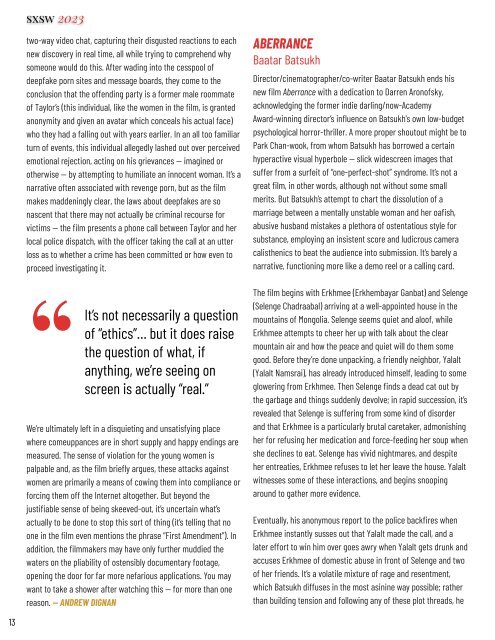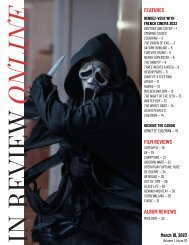You also want an ePaper? Increase the reach of your titles
YUMPU automatically turns print PDFs into web optimized ePapers that Google loves.
sxsw 2023<br />
two-way video chat, capturing their disgusted reactions to each<br />
new discovery in real time, all while trying to comprehend why<br />
someone would do this. After wading into the cesspool of<br />
deepfake porn sites and message boards, they come to the<br />
conclusion that the offending party is a former male roommate<br />
of Taylor’s (this individual, like the women in the film, is granted<br />
anonymity and given an avatar which conceals his actual face)<br />
who they had a falling out with years earlier. In an all too familiar<br />
turn of events, this individual allegedly lashed out over perceived<br />
emotional rejection, acting on his grievances <strong>—</strong> imagined or<br />
otherwise <strong>—</strong> by attempting to humiliate an innocent woman. It’s a<br />
narrative often associated with revenge porn, but as the film<br />
makes maddeningly clear, the laws about deepfakes are so<br />
nascent that there may not actually be criminal recourse for<br />
victims <strong>—</strong> the film presents a phone call between Taylor and her<br />
local police dispatch, with the officer taking the call at an utter<br />
loss as to whether a crime has been committed or how even to<br />
proceed investigating it.<br />
“It’s not necessarily a question<br />
of “ethics”… but it does raise<br />
the question of what, if<br />
anything, we’re seeing on<br />
screen is actually “real.”<br />
We’re ultimately left in a disquieting and unsatisfying place<br />
where comeuppances are in short supply and happy endings are<br />
measured. The sense of violation for the young women is<br />
palpable and, as the film briefly argues, these attacks against<br />
women are primarily a means of cowing them into compliance or<br />
forcing them off the Internet altogether. But beyond the<br />
justifiable sense of being skeeved-out, it’s uncertain what’s<br />
actually to be done to stop this sort of thing (it’s telling that no<br />
one in the film even mentions the phrase “First Amendment”). In<br />
addition, the filmmakers may have only further muddied the<br />
waters on the pliability of ostensibly documentary footage,<br />
opening the door for far more nefarious applications. You may<br />
want to take a shower after watching this <strong>—</strong> for more than one<br />
reason. <strong>—</strong> ANDREW DIGNAN<br />
ABERRANCE<br />
Baatar Batsukh<br />
Director/cinematographer/co-writer Baatar Batsukh ends his<br />
new film Aberrance with a dedication to Darren Aronofsky,<br />
acknowledging the former indie darling/now-Academy<br />
Award-winning director’s influence on Batsukh's own low-budget<br />
psychological horror-thriller. A more proper shoutout might be to<br />
Park Chan-wook, from whom Batsukh has borrowed a certain<br />
hyperactive visual hyperbole <strong>—</strong> slick widescreen images that<br />
suffer from a surfeit of “one-perfect-shot” syndrome. It’s not a<br />
great film, in other words, although not without some small<br />
merits. But Batsukh’s attempt to chart the dissolution of a<br />
marriage between a mentally unstable woman and her oafish,<br />
abusive husband mistakes a plethora of ostentatious style for<br />
substance, employing an insistent score and ludicrous camera<br />
calisthenics to beat the audience into submission. It’s barely a<br />
narrative, functioning more like a demo reel or a calling card.<br />
The film begins with Erkhmee (Erkhembayar Ganbat) and Selenge<br />
(Selenge Chadraabal) arriving at a well-appointed house in the<br />
mountains of Mongolia. Selenge seems quiet and aloof, while<br />
Erkhmee attempts to cheer her up with talk about the clear<br />
mountain air and how the peace and quiet will do them some<br />
good. Before they’re done unpacking, a friendly neighbor, Yalalt<br />
(Yalalt Namsrai), has already introduced himself, leading to some<br />
glowering from Erkhmee. Then Selenge finds a dead cat out by<br />
the garbage and things suddenly devolve; in rapid succession, it’s<br />
revealed that Selenge is suffering from some kind of disorder<br />
and that Erkhmee is a particularly brutal caretaker, admonishing<br />
her for refusing her medication and force-feeding her soup when<br />
she declines to eat. Selenge has vivid nightmares, and despite<br />
her entreaties, Erkhmee refuses to let her leave the house. Yalalt<br />
witnesses some of these interactions, and begins snooping<br />
around to gather more evidence.<br />
Eventually, his anonymous report to the police backfires when<br />
Erkhmee instantly susses out that Yalalt made the call, and a<br />
later effort to win him over goes awry when Yalalt gets drunk and<br />
accuses Erkhmee of domestic abuse in front of Selenge and two<br />
of her friends. It’s a volatile mixture of rage and resentment,<br />
which Batsukh diffuses in the most asinine way possible; rather<br />
than building tension and following any of these plot threads, he<br />
13
















